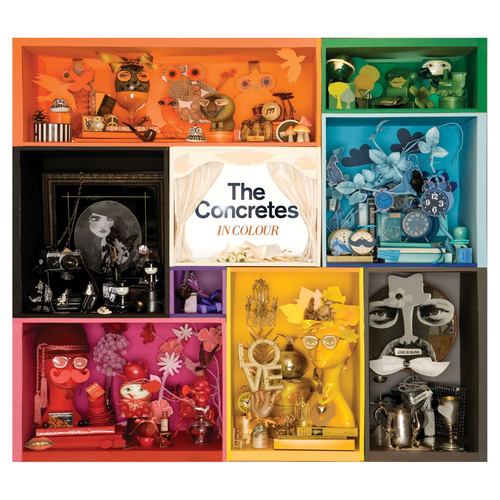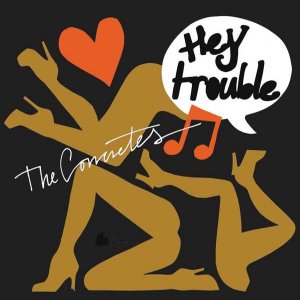
Come's Near Life Experience (1996) is something of an indie rock party with members of Tortoise, the Jesus Lizard and Rodan (who made possibly my favourite album) all filling in the rhythm section parts. It doesn't sound like a party though. Not at all. It sounds like Thalia Zedek's usual rasping, grinding blues-based grim indie-rock. The songs are solid, the performances are superb, but there's something not quite right about Near Life Experience. Possibly the problem is that (the wonderful) Tara Jane O'Neil and Kevin Coultas' bass and drums are more coherent and organic than Bundy Brown and Mac McNeilly's, possibly it's just that the tunes don't gel with each other, but whatever the reason, although the songs are good on their own, as an album it just doesn't quite work. After the brilliance of debut 11:11 and follow-up Don't Ask, Don't Tell, Near Life Experience feels disjointed. The slower numbers are too much of a grind ('Weak as the Moon') and sometimes Chris Brokaw's contributions sound surprisingly obviously indebted to Sonic Youth. Overall it's a decent album but not one of the true greats of the late 90's indie renaissance.

Ahhh, Sweden's lovely Concretes - I love the Concretes. I think their casual, crawling way with a classically styled pop song is absolutely fabulous and the fact that Victoria Bergsman's songwriting and vocal style have influenced large swathes of the indie community is testament to just how effective she is. The gently swirling keyboards and delicate little guitar filigrees behind her soft but clear, slightly slurred voice, make for some fantastic pop. The slower numbers are easily as successful as the big show-off numbers and despite the fact that the most famous tune from the eponymous debut studio album (2003) is the urgent pop of 'You Can't Hurry Love', it's the ballad form songs that are the real winners ('Lovin' Kind' is an absolute stand-out) and as indie-pop records go, this really is the real deal. Surprisingly the Concretes followed up the debut with a second compilation LP (their first album being a compilation of their first two EPs). Layourbattleaxedown (2005) is a selection of disperate tracks that had first appeared in a variety of locations, B-sides, compilation albums, etc. As such it's a mixed bag, but on the whole it does show just how high their quality threshold was when potentially throwaway material is this good, and there's a real diversity of stuff, some of which is very bold (the strings on 'Lady December' are amazing). There are some absolute charmers on Layourbattleaxedown ('Sugar' is lovely for instance) and although it's unsurprisingly somewhat uneven, it's a great Sunday listen, rain or shine...


The Concretes finest album was released next, The Concretes In Colour (2006). All of the most pronounced pop song inclinations they had shown come to their fullest fruition on In Colour. These are simply fabulous indie-pop songs, which are alive with a brisk grace. The melancholy edge that had been an essential element of their previous records is almost entirely lacking from In Colour, this is just joyous, ebullient testimony to the huge value of pop music. It opens and closes with grand statements ('On the Radio', 'Song for the Songs') and is littered throughout with perfect examples of the form ('Sunbeams' and 'Grey Days' worthy of particular mention). It's wonderful. Finally, things don't go quite so well for Hey Trouble (2007). After Bergsman left, drummer Lisa Milberg took over vocal duties and the songwriting was duty split, and with Bergsman's departure something of the spirit of the band went with her. It's still a fine album, but the gloom seems to have set in again and doubly so, and there's a something a little leaden about the atmosphere of Hey Trouble. The songs don't bounce or swagger, they mutter and shamble instead, and although it has some great tunes on it, on the whole it's a bit of a downer, and without Bergsman's voice the melancholy doesn't seem to have a real purpose.


Will Oldham and Dave Pajo put their heads together as the Continental Op to make the soundtrack to an experimental film and Slitch Music (2003) was the result. It's a series of instrumental mood pieces essentially, but in a variety of styles, from gentle minimal acoustic works to scuzzy grungy noise pieces, but although the talents of the two are enviable, Slitch Music has something of a treading-water feel to it. It's interesting to the extent that hearing the output of an experimental approach from Oldham and Pajo would always be interesting, but there isn't really anything sufficiently remarkable to mark it out as a singular work.

Quite a lengthy Ry Cooder session now, starting with second album Into the Purple Valley (1972). Cooder is a past master at the bluesy, rootsy Americana and his slide guitar playing is absolutely second to none (in fact he's astonishingly adept at most instruments he turns his hand to). As a musicologist too Cooder has consistently proven himself to be engaged and adaptable and it's this questing spirit that has always infused his records with a sense of consummate musicianship, even when he's effectively just mucking about. Into the Purple Valley is a demonstration of his early fascination with American self-mythologising and concentrates on dustbowl era or dustbowl themed songs and as such also demonstrates a burgeoning leftist political frankness which has become increasingly open and furious as the years have gone by. The choices of songs to cover are perfect, unsurprisingly, with lesser known Woody Guthrie and Leadbelly tunes amongst his expert interpretations. It's an album with a knowing sense of humour simultaneous to its fastidious attention to detail and as a result it's both brilliant and highly entertaining. For some reason I haven't got the next two great Cooder albums so go straight on to fifth album, Chicken Skin Music (1976). Cooder's expertly casual musical multiculturalism is at its finest, and subtlest here, blending mariachi accordion with gospel vocal groups and Hawaiian rhythms with folky Americana, and all of it works because of the evident straightforward certainty on Cooder's part that it simply will. Again there are a couple of Leadbelly songs on Chicken Skin Music together with a selection of other stylistically diverse covers and traditional songs, and it all blends seamlessly into one hugely enjoyable whole.


No comments:
Post a Comment